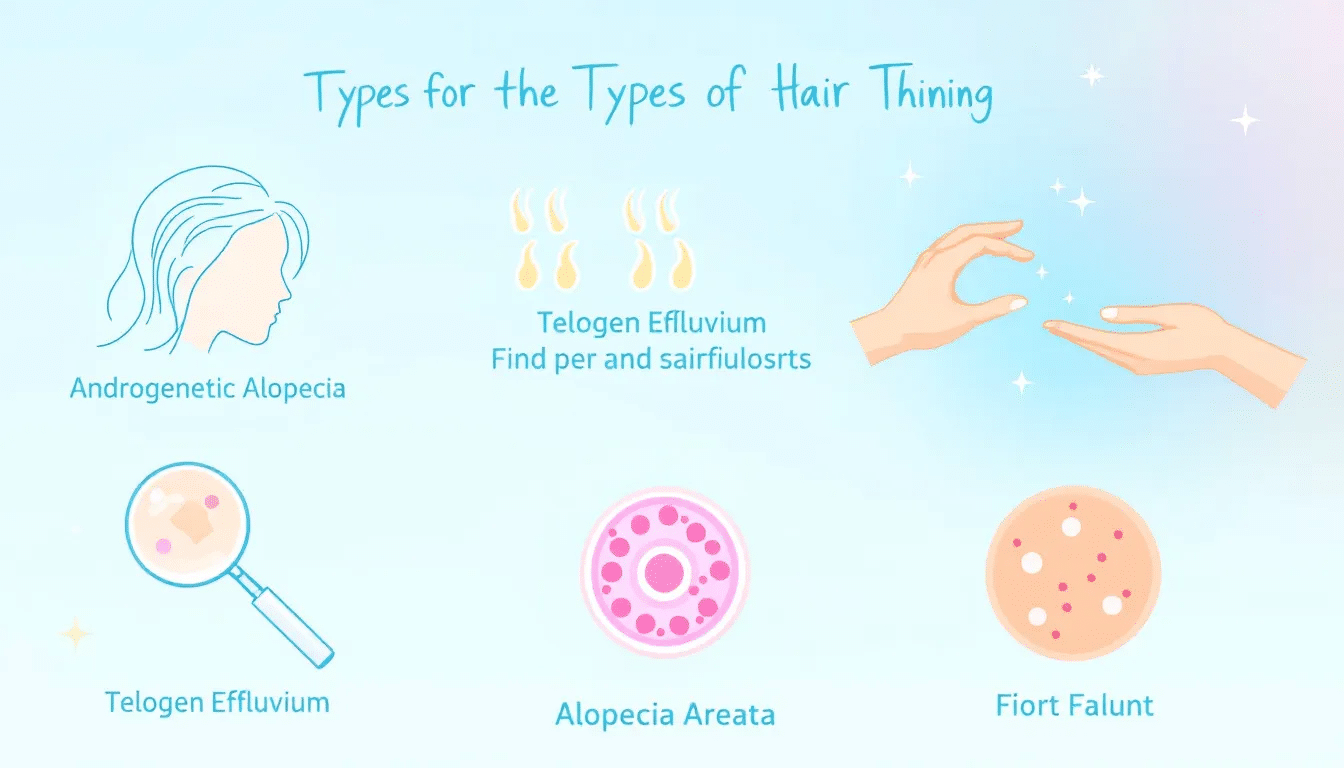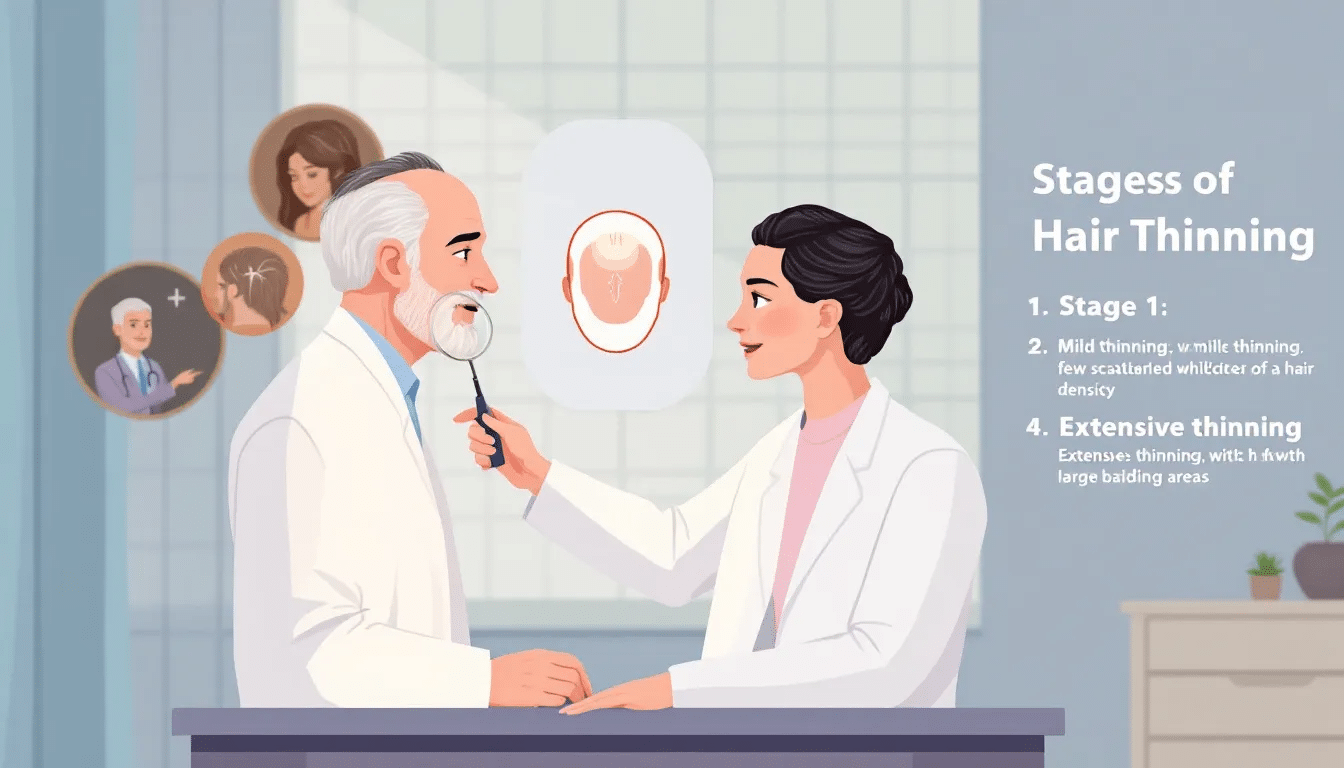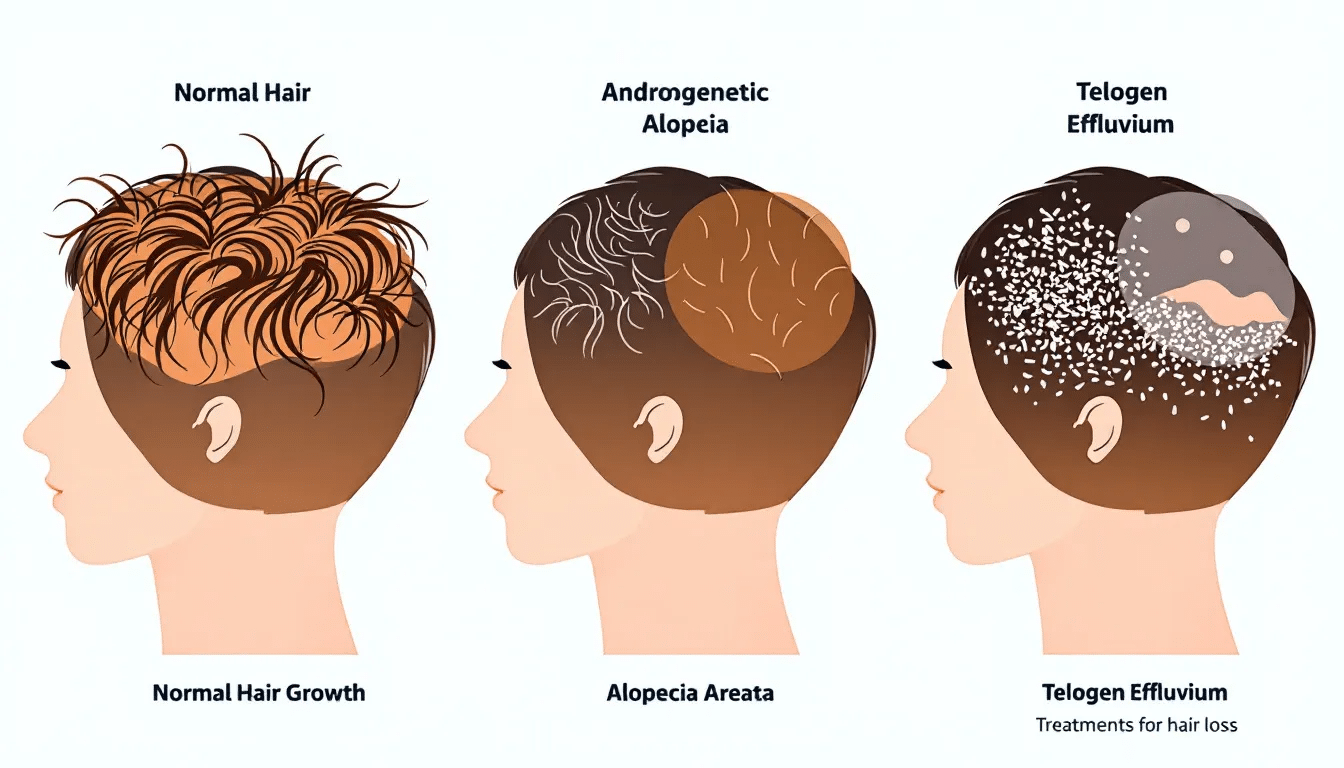Struggling with thinning of hair? This article explains why it happens and shares practical treatments and tips to help you manage and improve your hair health.
Key Takeaways
Thinning hair can result from genetic predispositions, hormonal changes, medical conditions, stress, and lifestyle choices, necessitating a tailored treatment approach.
Effective treatments for thinning hair include topical applications like Minoxidil, oral medications such as Finasteride, and dietary supplements to address underlying deficiencies.
Preventative measures, including gentle hair care techniques, balanced nutrition, and stress management, can significantly reduce hair thinning and support healthier hair growth.
Understanding Thinning Hair

Thinning hair is characterized by a decrease in hair density, leading to a more visible scalp. It’s a condition that can affect anyone, regardless of age or gender. While hair loss is commonly caused by heredity, hormonal shifts, medical conditions, or the aging process, recognizing the early signs of thinning hair is crucial for timely treatment and prevention.
Thinning hair can manifest in various forms and severities. From temporary hair thinning to persistent hair loss, each type requires a tailored approach to treatment. Identifying the specific type of hair loss helps in navigating the available treatments and solutions.
Understanding the hair growth cycle and the factors that disrupt it is key to maintaining hair health. With this foundation, we can move on to explore the common causes of thinning hair and the types of hair loss that individuals may encounter.
Common Causes of Thinning Hair
Thinning hair can result from a myriad of factors, ranging from genetic predispositions to lifestyle choices. Understanding these causes is the first step in addressing and managing hair thinning effectively. Hereditary factors play a significant role, with genetic predisposition leading to conditions like androgenetic alopecia, commonly known as male or female pattern hair loss.
Hormonal changes, such as those occurring during menopause or due to hormonal medications, are another common cause of hair thinning. Medical conditions like thyroid disorders and anemia also contribute significantly to this issue. Additionally, stress and lifestyle choices, including diet and overall health habits, can impact hair density and growth.
Identifying the underlying cause of hair thinning helps in selecting the appropriate treatment. Let’s delve deeper into each of these causes to understand their specific impacts on hair health.
Genetic Factors
Hereditary hair loss, often referred to as androgenetic alopecia, is a significant factor contributing to thinning hair. This type of hair loss, also known as male or female pattern hair loss, affects over 50 million men and 30 million women in the U.S. alone. It is characterized by a gradual thinning of hair over time, typically starting at the crown or the front of the scalp, where losing hair falls more noticeably.
Recognizing the genetic components of hair loss aids in identifying early signs and seeking timely intervention. While hereditary hair loss is permanent, early treatment can slow the progression and improve hair density.
Hormonal Changes
Hormones play a pivotal role in regulating the hair growth cycle, influencing phases such as growth, transition, and rest. Imbalances in hormones, such as thyroid hormone levels, can lead to diffuse hair thinning across the scalp. Elevated cortisol levels from stress can also halt hair growth and contribute to hair loss.
Women often experience significant hair thinning during menopause due to reduced estrogen levels. Similarly, hormonal imbalances caused by birth control pills or conditions like polycystic ovary syndrome (PCOS) can lead to noticeable hair loss in women. Medical treatments can address hormonal changes, restoring balance and promoting healthier hair growth.
Medical Conditions
Various medical conditions can adversely affect hair health. Thyroid disorders and anemia are common culprits, leading to hair thinning due to disrupted metabolic processes. Telogen effluvium, triggered by medical events such as surgery, fever, or vitamin deficiencies, results in temporary hair shedding.
Alopecia areata, an autoimmune condition, causes round patches of hair loss on the scalp and other areas like the eyebrows and beard. Discoid lupus erythematosus and tinea capitis are other medical conditions that can lead to hair loss because inflammation destroys hair follicles or fungal infections.
Awareness of these conditions allows for targeted treatments and improved hair health.
Stress and Lifestyle
Significant stress can trigger hair thinning, often occurring months after the stressful event. This type of hair loss, known as telogen effluvium, is typically temporary but can be distressing. Reducing stress is vital for preventing hair thinning and promoting overall hair health.
Lifestyle choices, such as poor diet and high stress levels, can exacerbate hair thinning. Adopting a balanced diet and stress management techniques, such as meditation and regular exercise, can mitigate these effects and support healthier hair growth.
Types of Hair Thinning

Hair thinning manifests in various forms, affecting both men and women differently. Understanding the specific type of hair thinning you’re experiencing is key to finding the most effective treatment. Female pattern hair loss, telogen effluvium, and traction alopecia are among the most common types.
Before:
Each type has unique characteristics and underlying causes. Female pattern hair loss, for example, is often linked to genetic and hormonal factors, while telogen effluvium is typically triggered by stress or medical events. Traction alopecia, on the other hand, results from physical stress on the hair follicles due to tight hairstyles.
After:
Each type has unique characteristics and underlying causes:
Female pattern hair loss is often linked to genetic and hormonal factors.
Telogen effluvium is typically triggered by stress or medical events.
Traction alopecia results from physical stress on the hair follicles due to tight hairstyles.
Identifying the type of hair thinning allows for tailoring the treatment approach to address specific contributing factors.
Female Pattern Hair Loss
Female pattern hair loss, also known as androgenetic alopecia, is characterized by thinning all over the scalp, usually without significant receding hairline. This condition affects the crown of the head and can begin at any time after puberty. Unlike male pattern hair loss, female pattern hair loss rarely leads to complete baldness.
This gradual thinning process can be distressing, but early intervention with treatments like Minoxidil can help slow the progression and improve hair density. Comprehending the hormonal and genetic factors is crucial for effective management.
Telogen Effluvium
Telogen effluvium is a non-scarring type of hair loss where hair follicles enter a resting phase, leading to significant shedding. This condition can be triggered by various factors, including stress, illness, or major life events, resulting in the temporary shedding of 300 to 500 hairs daily.
While telogen effluvium is typically temporary and allows for eventual regrowth, it can be alarming. Addressing the underlying trigger is vital for recovery and regaining hair health.
Traction Alopecia
Traction alopecia arises from tight hairstyles that apply excessive force on hair strands, leading to thinning hair or bald spots. If the hairstyle is not changed, it may result in permanent hair loss.
The good news is that most of the time, hair grows back after altering a tight hairstyle. Avoiding stress on hair follicles is fundamental for preventing traction alopecia and maintaining healthy hair to help regrow hair.
Diagnosing Thinning Hair

Diagnosing thinning hair involves a comprehensive approach that starts with a physical examination and a review of the patient’s diet, hair care habits, and medical history. Doctors may perform a pull test to assess the number of hair strands that come out, helping to gauge the shedding stage.
Light microscopy can be used to examine hair shafts, enabling the detection of potential disorders affecting hair structure. Observing the pattern of hair loss also provides crucial insights into the underlying causes. Seek medical advice if you notice sudden or patchy hair loss, or excessive shedding while combing or washing.
An accurate diagnosis helps in selecting the appropriate treatment and managing hair thinning effectively. A clear understanding of the underlying causes allows for targeted treatments addressing specific issues.
Effective Treatments for Thinning Hair

Treating thinning hair effectively often requires a multi-faceted approach to treat thinning hair, combining medications, dietary changes, and lifestyle adjustments. Common treatments include topical applications like Minoxidil and oral medications such as Finasteride. Moisturizing shampoos can help retain moisture, making hair look thicker and fuller, and may slow thinning by reducing breakage.
Home remedies, including natural oils and scalp massages, can also improve hair strength and overall health. The choice of hair loss treatment depends on the underlying cause of hair thinning. Understanding the specific factors contributing to hair loss helps in developing a tailored treatment plan for your unique needs.
Minoxidil
Minoxidil is a popular treatment for thinning hair, applied directly to areas of hair loss in strengths of 2% or 5%. Studies have shown that Minoxidil can result in significant hair growth after six months of consistent use.
However, discontinuing Minoxidil will cause hair loss to recur. Consistent application is necessary for maintaining benefits and promoting hair density.
Finasteride
Finasteride is an oral medication used primarily for treating male pattern hair loss. The recommended daily dosage is 1 milligram, which helps in reducing the levels of DHT, a hormone responsible for shrinking hair follicles.
While effective in promoting hair growth and preventing further thinning, Finasteride is typically prescribed for men and not recommended for use by women. Consulting a healthcare provider helps determine if this treatment suits your condition.
Nutritional Supplements
Nutritional supplements are vital for maintaining healthy hair. Vitamins and minerals such as A, B, C, D, E, iron, selenium, and zinc are essential for hair health. Supplements can help address hair thinning caused by dietary deficiencies.
Coconut oil, rich in vitamin E and antioxidants, and pumpkin seed oil, which may inhibit DHT formation, are beneficial for hair growth and health. Incorporating these supplements into your diet promotes stronger, healthier hair.
Natural Remedies and Lifestyle Changes
Incorporating natural remedies and lifestyle changes can provide additional support in addressing hair thinning. A balanced diet rich in essential nutrients is key to overall hair health. Proteins, fats, vitamins, and minerals play a crucial role in supporting healthy hair growth.
Regular scalp massages can promote blood flow and support healthier hair growth. Essential oils, such as peppermint and rosemary, can also stimulate circulation and improve scalp health. These natural remedies can enhance the effectiveness of other treatments.
Diet and Nutrition
A balanced diet is essential for hair health. It promotes strong and healthy hair growth. Proteins, fats, vitamins, and minerals are vital for maintaining healthy hair. These nutrients play a key role in promoting hair strength and growth. Including these nutrients in your diet helps mitigate hair thinning and supports overall hair growth.
Essential Oils and Scalp Massage
Essential oils and scalp massages offer multiple benefits for hair growth. Peppermint oil stimulates circulation, while rosemary oil improves scalp health and increases blood flow.
Diluting these oils with carrier oils like jojoba or coconut oil is recommended for safe application.
Stress Management
Stress and lifestyle choices play a significant role in hair thinning. Telogen effluvium, a condition characterized by hair shedding triggered by stress, illness, or other life events, can push hair follicles into a resting phase. Stress management techniques like meditation, exercise, and proper sleep can mitigate hair loss and promote overall hair health.
Reducing stress creates a favorable environment for hair growth, preventing temporary hair thinning from becoming persistent. Making conscious lifestyle changes can have profound health benefits, including for your hair.
Preventing Further Hair Loss

Preventing further hair loss involves adopting gentle hair care techniques and avoiding harsh chemicals in hair products. Choosing hairstyles that do not pull on the hair can also prevent traction-related hair loss.
Natural remedies, such as incorporating essential oils and maintaining a balanced diet, can be economical options to treat hair loss caused by environmental factors. By being proactive, you can slow hair loss and maintain healthier hair.
These changes can significantly reduce hair thinning and promote better hair health. Consistency with these practices is vital for long-term benefits.
Can Thinning Hair Grow Back?
The potential for thinning hair to grow back largely depends on the underlying cause. Medical treatments like Minoxidil can help restore hair growth due to aging or hormonal changes. Hair that falls out from health issues typically regrows eventually. It often takes time for this process to occur.
Postpartum hair loss and hair loss from chemotherapy typically resolve on their own, with hair returning within several months. If the triggering event for telogen effluvium is temporary, hair may grow back after six months. However, hereditary hair loss often requires professional intervention for significant regrowth.
Some forms of hair loss are reversible, while others, like trichotillomania or severe alopecia areata, may result in permanent lose hair. Consulting healthcare professionals helps determine the best course of action for your specific condition.
Summary
In summary, understanding the causes and types of hair thinning is essential for selecting the right treatment and prevention strategies. From genetic factors and hormonal changes to medical conditions and stress, various elements contribute to hair thinning. Each requires a tailored approach to manage effectively.
Treatments like Minoxidil and Finasteride, along with nutritional supplements and natural remedies, offer hope for those experiencing hair thinning. Combining these treatments with lifestyle changes can significantly improve hair health and slow further loss.
Taking proactive steps today can lead to healthier, fuller hair tomorrow. Embrace the journey of understanding and addressing hair thinning with confidence, knowing that effective solutions are within reach.
Frequently Asked Questions
What are the common causes of thinning hair?
Thinning hair is commonly caused by genetic predispositions, hormonal changes, medical conditions, and lifestyle factors like stress and poor diet. Understanding these causes can help you address the issue more effectively.
How can I diagnose the cause of my hair thinning?
To effectively diagnose the cause of your hair thinning, it is essential to consult a doctor for a thorough examination, assess your dietary and hair care practices, and consider tests such as the pull test or light microscopy. Seeking professional guidance will help pinpoint the underlying issue.
Are there effective treatments for thinning hair?
Effective treatments for thinning hair include Minoxidil, Finasteride, and nutritional supplements, along with natural remedies and lifestyle changes that promote overall hair health.
Can thinning hair grow back?
Thinning hair can often grow back depending on its cause, particularly with appropriate treatment. Conditions such as telogen effluvium may improve naturally, while hereditary hair loss might necessitate continuous intervention.
What lifestyle changes can help prevent hair loss?
To effectively prevent hair loss, it is essential to adopt gentle hair care practices, avoid harsh chemicals, manage stress, and maintain a balanced diet. These lifestyle changes can promote healthier hair growth and mitigate further loss.
[/et_pb_text][/et_pb_column] [/et_pb_row] [/et_pb_section]